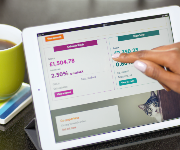Card cloning and skimming: how to stay safe

Card cloning is on the rise. Here’s how to stay safe and how to spot a debit or credit card skimmer.
Card cloning is on the rise in the UK, with someone in the UK falling victim on average every four minutes, according to campaign group Financial Fraud Action UK.
The practice helps criminals steal more than £47 million every year.
To help you stay safe, we explain everything you need to know about card cloning, including how to stay safe and how to spot an ATM or cash point that has been tampered with.
Check your credit report for signs of suspicous activity
What is card skimming?
A common way cards can be cloned is through the use of a card skimmer.
This is a capture device that allows a criminal to record all the data on a card so they can they take money from the victim's account.
A card skimmer is most often placed on ATM card slots, but criminals have been known to put them on any machine that accepts debit and credit cards, such as ticket machines at the train station.
Less sophisticated card-skimming cons also require the criminals to capture your PIN separately, and so they will install a tiny camera pointing at the keypad.
These are often built into a false front on the machine and can be extremely difficult to spot.
How to spot a card skimmer
There are a number of tell-tale signs a machine has been tampered with. Keep an eye out for:
- A bulky card slot
- A loose or blocked card slot
- A loose or ‘spongey’ pin pad
You can get far more information on this, plus see photos of card skimmers, in this article on spotting an ATM that scammers have tampered with.

How to stay safe
If it’s not immediately obvious a card skimmer is in place, there are a few more things you can do to stay safe.
Try giving the keypad and card slot a wiggle. If either feels loose then don’t insert your card at all.
Second, do your best to cover the keypad when entering your PIN just in case there’s a camera installed.
Finally, if the machine swallows your card then call the bank while you’re still in front of the machine, if you can.
What to do if you spot a machine that’s been tampered with
If you suspect that something isn’t quite right, don’t insert your card, obviously.
You should also report it to the police. Don’t be tempted to take any of the devices away as the gangs could come after you to get them back.
Check your credit report for signs of suspicous activity
Card skimming: how my husband fell victim
Last week, we saw how this kind of fraud works first hand. My husband received a text from his bank asking if he really was buying £950-worth of stuff in Sports Direct.
Since he was at work (and isn’t exactly a fan of sports fashion), it was fairly obviously not him.
But what confused us was that his card hadn’t been stolen; it was still in his wallet.
And we take card security very seriously.
When paying in shops or restaurants, he knows not to let the credit card out of his sight and he certainly hadn’t used any disreputable website – the only recent purchases had been booking a holiday on a travel comparison site and paying for a book on Amazon.
Numerous small purchases
My husband’s fraudsters were caught when they tried to make a massive purchase. However, before they were caught they had spent over £1,000 through smaller transactions over the preceding week.
Because the amounts were small, the bank hadn’t flagged them as suspicious. That means that if my other half had checked his statement more regularly, he might have noticed the fraud sooner.
If you’re even slightly worried about the security of your account, or think your card may have been put at risk then contact your provider as soon as possible. They can freeze your account and send a new card out that day.
Smooth transaction
Fortunately, innocent victims aren’t left in the lurch when this kind of fraud takes place.
My husband’s bank immediately froze the card and opened a separate account.
He helped them identify the real debts, which were moved over, so there was no risk that his monthly payment would be unexpectedly high.
But there’s no denying that it was an unnecessary faff. There was time spent on the phone to the bank, time spent combing through the statements and the hassle of a new credit card number.
So it’s important to keep yourself as safe as possible.
This article is regularly updated
More on scams:
How to protect your PINs and passwords
The smartphone app scam
Watch out for these HMRC tax refund scams
Most Recent
Comments
-
Lets be Honest EMV credit card are not safe and they can be clone,bay a simple search over google i find a software that is able to clone any emv chip, EMV Reader Writer Software v8.6 from emv global solution
REPORT This comment has been reported. -
Not really for this article, but to stop your contactless card being cloned, punch a hole or cut off a corner to destroy the "aerial" that is embedded in the card. It then becomes a non-contactless card.
REPORT This comment has been reported. -
My credit card was cloned without ever leaving my desk drawer at home, probably through the internet. It purposely has a £500 limit for telephone and internet purchases. After the £10 test purchase, the virtual thief had tried to book a Lufthansa flight. You don't get far with Lufthansa on less than £500. The card company contacted me after freezing my card.
REPORT This comment has been reported.
Do you want to comment on this article? You need to be signed in for this feature









31 January 2017